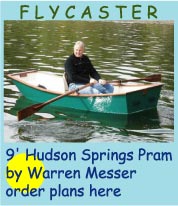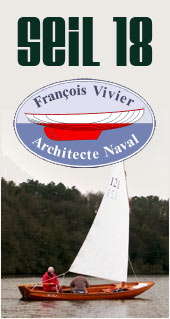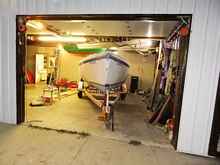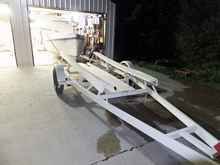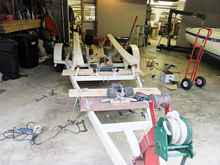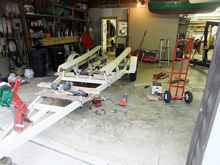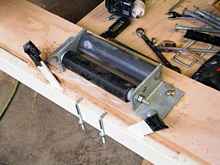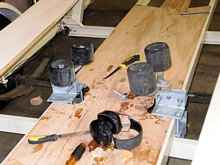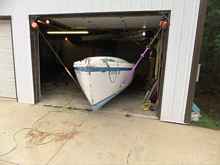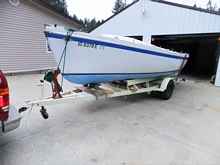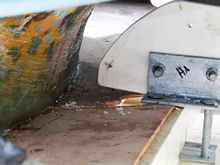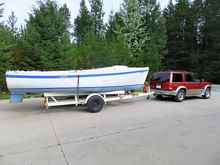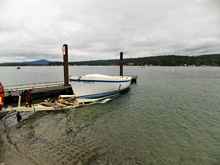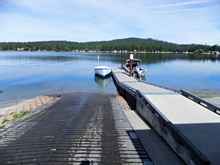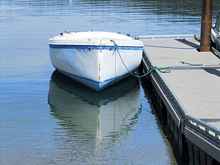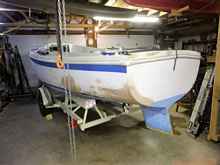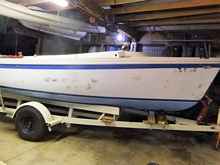
 Custom Search
|
| boat plans |
| canoe/kayak |
| electrical |
| epoxy/supplies |
| fasteners |
| gear |
| gift certificates |
| hardware |
| hatches/deckplates |
| media |
| paint/varnish |
| rope/line |
| rowing/sculling |
| sailmaking |
| sails |
| tools |
| join |
| home |
| indexes |
| classifieds |
| calendar |
| archives |
| about |
| links |
| Join Duckworks Get free newsletter CLICK HERE |
|
|
| The Birthing of Miss Kathleen - Part Four |
by Dan Rogers - Diamond Lake, Washington - USA |
Part One - Part Two - Part Three - Part FourIt takes a lotta guzzintas. In this case, it’s guzzintadawater. And out. And, back in. Dry. Repeat. And, then, we come home and lift her off and drill more holes - albeit with great trepididdity, preparation, and with the lowest-powered drill that can spin the bit. Mostly, holes are punched on the drill press, these days. With clamps, and drill vise, and sharp bits, and safety gear, and… But, like that purloined verse that I pinned onto the Texas 200 home page, “…his wounds are almost healed…” Soooooo, it’s not all about idle chit chat, that I iterate the lessons learned, shared, compared, and repeated about drilling holes into steel with mechanical devices of greater power than aging wrists and metacarpals and connective tissues. Anyhow. Miss Kathleen’s remodeled trailer is just about figured out. And, it’s taken the better parts of a couple work days to get this far. I suppose the REAL TRAILER GUYS already would have this stuff figured out. In my case, I find myself locked in “long passionate gazes” with left-over rollers, and clamps, and odd-sized bolts of inconvenient threat count. I’ve been attempting to put this part of the project together with stuff from the “spares locker.” Actually, a lot of it has been languishing in piles, heaps, on shelves, in boxes, coffee cans, and worse.
The supports for the bunks came from pieces sawn out of base frames from a HF shop crane that got expropriated for use on Alice the Tractor. And, a lot of the “official” trailer parts have come up surplus from any and all of the half-dozen boat trailers that wandered into my cross hairs and got re-done, re-purposed, and ultimately sent away with boats of similar etiology. As a result, the leftside don’t always exactly match the rightside.
The biggest reason we keep coming and going to the launch ramp is to decide how to make the boat roll easily into and out of the water - while riding a solidly as possible during those over-the-road interregna. You see, my sophomore geometry teacher, Mr. Robertson, made me a promise of sorts. Back in high school. He offered to give me a passing grade, if I swore on a stack of Euclidian tables and theorems and postulates that I would never take another math class from him, again. You could say that my arithmetic acumen is somewhat deficient. Where the RTG’s can probably figure this stuff out with a tape measure, bevel square, and a few properly-fitted parts; I have to pretty much do it by intuition. The biggest wunderwhat has been the changes in bearing, and trim angles, as the stern sections enter/leave the water. This is also a function of how deep the package is immersed, and ultimately a function of the ramp angle. And, I have to sort of guess how this will modify itself when essentials like motor, and gas tanks, and dry socks and Dinty Moore cans are added - not to mention the hundreds of pounds of lumber, plywood, ‘pox & glass, and general boat stuff that will sooner or later inhabit this rather fine-ended hull. The hurry-up has to do with the calendar. I really, really want to not only have the trailer figured out; but to have a real live test run under power in the logbook before Old man Winter reclaims the launch ramp. Actually, the Department of Fish & Game is taking on the role of in loco parentis for the ramp these days. For some undecipherable, bureaucratically obtuse reasoning, the guy with the lock comes and shutters the gate sometime in October. To protect the ramp from excessive wear and tear, maybe? You’d think a guy would notice all on his own if the ice was too thick to launch a boat into, now wouldn’t you? Anyhow. There is a reasonably complex set of constraints that I’m turning into progressively jumped-through hoops on the way to this particular Frankenbot opus. She’s gonna’ be something else! Garronntee… Today probably gives SSDD a bad name. And, at one point, I was pretty certain that SNAFU had self-upgraded to FUBAR without even holding a staff meeting. But, then, I wasn’t about to go to any meetings. I spent much of the day crawling under a now-familiar boat trailer, crawling back out to get another tool from the shop, and then back under - until the pile of tools under there started to get in the way of progress.
Perhaps there’s a synoptic message here: When you find yourself engaged in the “finishing touches” of an absolutely brilliant solution to a difficult problem that you are certain nobody else has ever attempted in quite this manner; STOP! Put your tools down, walk briskly away, go take a nap until the suppressed reality makes it obvious why nobody has attempted this before. You know. THAT MESSAGE. Somehow, I not only didn’t get invited to the meeting; I didn’t get the memo, either. As a putatively floating object with complex curves and variable buoyancy become progressively immersed, the whole angle of dangle gets messed with. That’s why I was under that trailer most of the day. Variable buoyancy. As I back this trailer with a 22 foot hull poised for departure into the lake, there’s a moment when the boat must decide if she will actually leave home - or not. Let’s just say that the ramp declines into the water at a constant 15 degrees or so. As the trailer continues to roll deeper into the water, the stern of the hull begins to float. That’s actually the mission. But, for a while the rest of the boat is still siding downhill with the trailer. Assuming you don’t want to end up on YouTube, you’ll stop the downward plunge before the car gets wet. This puts the weight of the bow on the forward supports, the stern behaving like a boat, and it’s now time to let your little girl leave the nest. In the case of Miss Kathleen, there is a pretty deep forefoot section that basically drops like a stone until the much broader midsection is floating properly. As this is happening, the bow is looking for a couple stair steps of some sort to bang down across first. Hence, the reason I was under that trailer all day. I was in the process of inventing, manufacturing, and installing a series of home brew rollers that should guide the boat into the center line as she comes back aboard the trailer, and make the slams against the trailer cross bars much more agreeable by substituting rollers, chocks, and lotsa large bolts and nuts. While it did take at least five times longer than the Planning guys so confidently predicted only last night; things were actually looking “put together” enough to try a test fit. Here’s the deal. The only reasonable way to get a boat that will weigh around a ton to climb on and off a boat trailer is to have it float most of the way. Anything fixed to the trailer that is supposed to guide the boat along the center line has to stick up high enough to engage the keel, and low enough not to impale the hull when no longer floating. Enter my genius contraptions:
Each one was dreamed up to guide and support the boat while riding around on the trailer, and while coming and going. This bottom picture was supposed to be the top of the heap. Rollers that would progressively align the foil-shaped stub keel into the center line. Things were looking real good. Until. Until I set the boat back down on the trailer, and discovered a game-ending flaw. The rollers worked like magic while the boat was still partially floating. When the lake is removed from the equation, the hull is perched on the roller tops. Not a good idea. I spent the next couple hours trying every which way to make this idea work. Not happening. Meanwhile, the boat had to be lowered and lifted about a dozen times.
After a while, even I get the message. This just isn’t gonna’ work. On to the next idea, finally.
This is a closeup, down at the “molecular level” where I can’t even put my hand, when the boat is on the trailer. Painfully simple. No moving parts. It guides the stub keel both up and down, but also side to side. It’s made out of scrap plastic. Temporarily stuck in place for a float test. It’ll probably work just fine. For years. Like most temp fixes seem to.
This is that same view, from about as close as this kid can wriggle - with the boat in the way. Sometimes, being ahead of the pack just doesn’t prove so much. Anyhow, this whole marathon with the trailer was simply to allow for quick in-the-water tests of the hull. First I need to look for leaks in my rather large patch job done to the bottom of the now truncated keel. Then, I’d like to do a short “sea trial” with motor in place to see if the rudder is going to be adequate, how high she sits with and without ballast, and stuff like that. So, it was off to the ramp. Again. And, then again.
Even after several re-patching attempts, there is a small leak at the bottom of the keel.
But, she floats. And, maneuvers pretty well under power. Time to get on with the next step in the program.
To celebrate our, somewhat looping, progress; before I knocked off the night crew - I had ‘em sand and apply fairing goop to the many blemishes and scars this hull has been sporting. A light re-sanding and a primer coat of paint are next. Things are looking up. |
To comment on Duckworks articles, please visit one of the following:
|
 |
